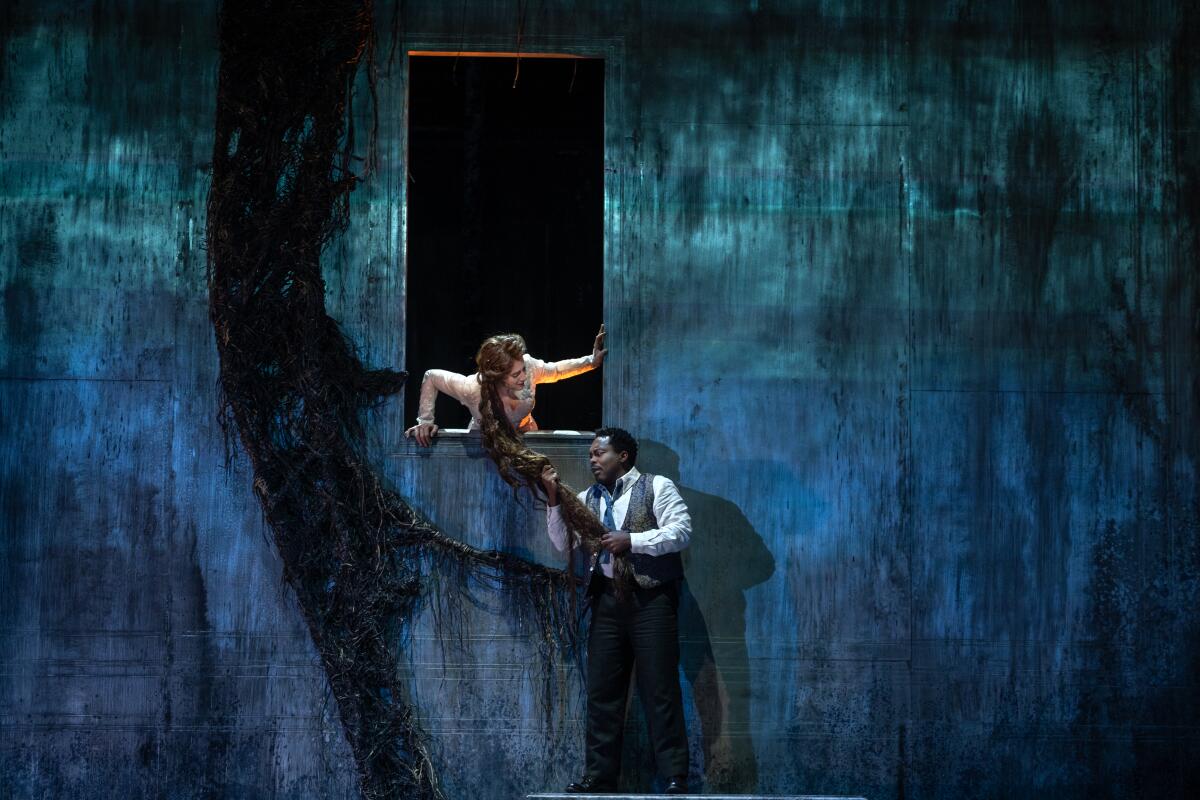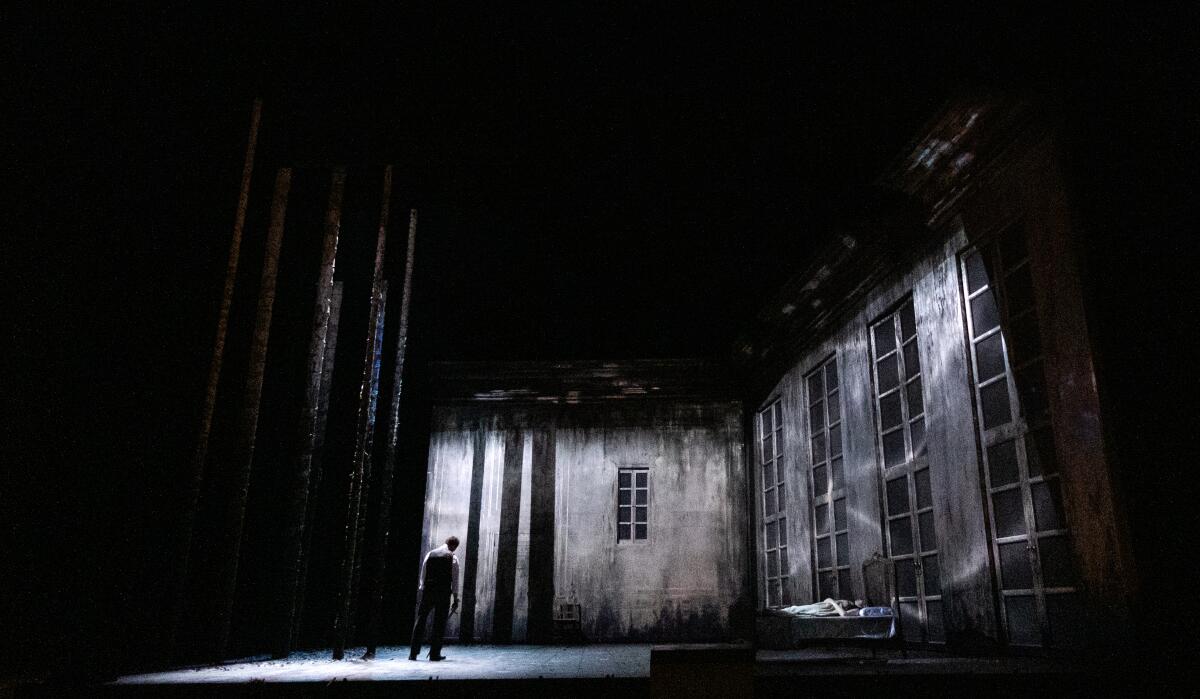Review: A consistently excellent cast shines in new L.A. Opera staging of ‘Pelléas et Mélisande’

- Share via
The first and only time, until Saturday, that Los Angeles Opera had mounted Debussy’s “Pelléas et Mélisande” was in 1995. The company, then Music Center Opera, was an ambitious 9-year-old newcomer to a Music Center with grand plans that included building Walt Disney Concert Hall and renovating the aging Dorothy Chandler Pavilion. Meanwhile, the city had its own high hopes in the process of recovering from the traumas of the early 1990s, including earthquakes, social unrest and a recession.
But Peter Sellars’ 1990s-era production, set in modern-day Malibu, reminded us that we first had to look truly at who we were. The mysterious French opera had its premiere in 1902 at a time when Paris was artistically reinventing itself into the city of 20th century modernism. Where might that lead? What did it mean?
Rather than offer answers, Debussy created a study of obfuscation and its consequences, an opera not of buoyant “La Bohème” Parisians with fantasies of greatness in their miserable garrets but characters disillusioned by fantasies in the presence of fate and nature.
In the process, Debussy opened opera up to the unknowing. Meaning in “Pelléas” is, as in life, hidden. Revelations lie like a buried treasure under the wondrous but imperturbable musical surface. Every detail contains a piece of the puzzle, a prize morsel to be unearthed. That becomes the job of each director, each singer and each conductor.
Sellars shocked with his discoveries in a staging resonant of that with which we still struggle, be it the LAPD menacing unhoused people or deadly family dysfunction hidden away in a sleek Malibu mansion, replete with racial and sexual implications. Whether admired or deplored, an L.A. “Pelléas” proved a radically prophetic act.
This time around in the Chandler, a neon-lit beach setting is replaced by the dismal cool of a decaying castle interior inspired by the muted sheen found in the canvases of Danish painter and Debussy contemporary Vilhelm Hammershøi. You don’t have to wait for dysfunction to reveal itself; it is apparent in every gloomy lighting cue and every emotionless hard surface of David McVicar’s 2017 production, which L.A. Opera has imported from Scottish Opera.
The claustrophobic set and period costumes by Rae Smith house a royal family as formal and chilly as their environment. Yet this, too, becomes a decidedly American “Pelléas” in its own right. There are no French voices. All in the consistently excellent cast are, with one exception, from California, Illinois, Iowa, Texas or New York. These are full-throated, demonstrative singers well practiced in the idioms of contemporary American opera, singers of our place and time.
Debussy’s opera, of course, typically asks for something somewhat different in the precise textural setting of Maurice Maeterlinck’s mysterious play. Mélisande is found lost in the woods by Golaud, a prince out hunting. She reveals nothing of her background. She responds to her environment and those in it directly, reflecting back whatever is said or done to her as though some kind of otherworldly magical mirror. Others find themselves and their place in the world through her.
She opens Pelléas, Golaud’s younger half-brother, to love. She brings out the angst and subdued violence in Golaud, whom she marries with seeming nonchalance. She offers the reminder of youth to King Arkel, the brothers’ grandfather. She brings to the castle needed woman’s perspective and companionship for Geneviève, mother to the clueless Golaud and Pelléas. But through it all, Mélisande remains impenetrable, a galvanizing life force from another world. Her voice seldom rises in volume, and sometimes she can barely be heard. Her music, though, is the most sublime in an opera that remains consistently ravishing for its full three hours.
Sydney Mancasola’s Mélisande takes unusual agency. She may be a character unknowable to others, but as vibrantly sung by this versatile soprano (who was to have starred in a 2021 L.A. Opera production of Missy Mazzoli’s “Breaking the Waves” that had to be canceled because of the pandemic), she presents a formidable strength.
Will Liverman, fresh from starring in Terence Blanchard’s “Fire Shut Up in My Bones” at the Metropolitan Opera and about to assume the role of Malcolm X in Anthony Davis’ “X,” is a boyishly eager Pelléas, with a beaming, high baritone that easily asserts.

The Golaud of Kyle Ketelsen, who also arrives fresh from the Met (in his case, Kevin Puts’ “The Hours”), does simmer. His is a subdued authority that nurses, as his angst comes out of hiding, deadly menace.
But both Susan Graham, as Geneviève, and the remarkable 11-year-old boy soprano Kai Edgar as Golaud’s son, Yniold, function on a different plane, and both sing with exquisite finesse. Whether Arkel is wise or a doddering old fool is a matter of question, which veteran Italian bass Ferruccio Furlanetto answers with a loud affirmation of the latter.
“Pelléas” comes to us courtesy of the company’s music director, James Conlon. In his preconcert talk, which can be heard as an “LAO” podcast, he calls Debussy’s transformative opera one of the great works of art. Period. The essence of the opera, moreover, lies in the orchestra, and it rewards conductors above all. On recordings, there are Abbado’s “Pelléas” and Karajan’s and Boulez’s and Salonen’s and Rattle’s.
In the Chandler, Conlon’s was a little harder to gauge — mainly due to difficulties of putting on “Pelléas” in a space lacking intimacy and its ever-awaited acoustic makeover. But a full-bodied richness, mellow yet effusive, does manage to rise from the pit. Heard in the downstairs seats, the higher-pitched instruments tended to be muted, and some solo instrumental passages lacked presence. Details more likely sparkle in the seats upstairs.
Seven years ago, Salonen conducted a concert performance of “Pelléas” with the L.A. Phil across the street at Disney, where everything could be heard with revelatory clarity. Let the L.A. Opera “Pelléas,” therefore, be a call for acoustical action at the Chandler. Debussy resisted the idea of concert performances of his opera. “Pelléas” demands, as L.A. Opera is now consequentially proving, staging.
Furthermore, as the performers become more comfortable with the space, they are certain to make critical acoustical adjustments throughout the consequential three-week run. And keep this in mind: Higher up in the Chandler is often where you get the best balance and where seats can be as inexpensive as $15. For a full performance of Debussy’s opera, which doesn’t come around all that often, and with singers, conductor and sets at this level, that could just be the best bargain in the performing arts anywhere in America.
'Pelléas et Mélisande'
Sung in French with English subtitles.
Where: Dorothy Chandler Pavilion, 135 N. Grand Ave., Los Angeles
When: Through Apr. 16. Check website for dates and times.
Pricing: $15-$284
Running time: Approximately 3 hours, 10 minutes, including one intermission.
Info: laopera.org, (213) 972-8001
More to Read
The biggest entertainment stories
Get our big stories about Hollywood, film, television, music, arts, culture and more right in your inbox as soon as they publish.
You may occasionally receive promotional content from the Los Angeles Times.











